The Intel Broadwell Desktop Review: Core i7-5775C and Core i5-5675C Tested (Part 1)
by Ian Cutress on June 2, 2015 7:45 AM ESTProfessional Performance: Windows
Agisoft Photoscan – 2D to 3D Image Manipulation: link
Agisoft Photoscan creates 3D models from 2D images, a process which is very computationally expensive. The algorithm is split into four distinct phases, and different phases of the model reconstruction require either fast memory, fast IPC, more cores, or even OpenCL compute devices to hand. Agisoft supplied us with a special version of the software to script the process, where we take 50 images of a stately home and convert it into a medium quality model. This benchmark typically takes around 15-20 minutes on a high end PC on the CPU alone, with GPUs reducing the time.
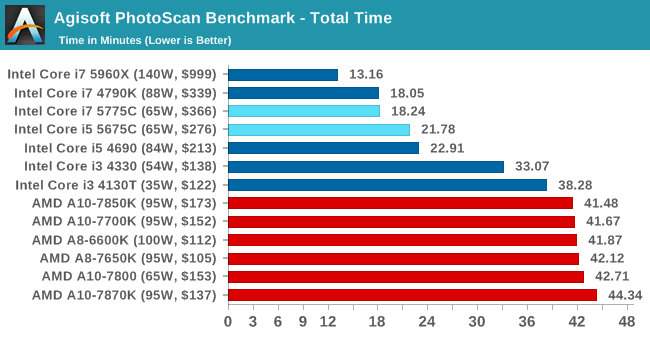
The presence of Crystal Well had a small effect on Photoscan, occurring mostly in the second phase of the calculation which is the one that also has an option to enable the GPU, indicating that memory bandwidth is an potential limitation in that segment.
Cinebench R15
Cinebench is a benchmark based around Cinema 4D, and is fairly well known among enthusiasts for stressing the CPU for a provided workload. Results are given as a score, where higher is better.
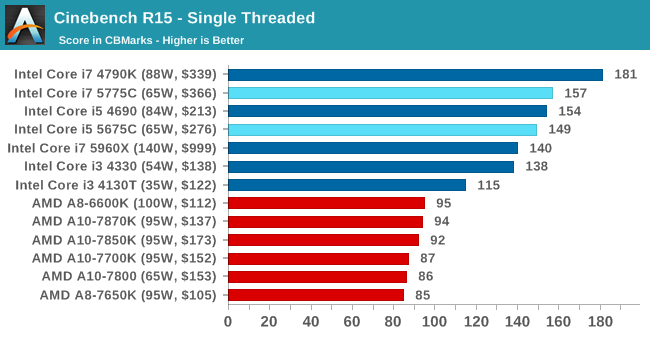
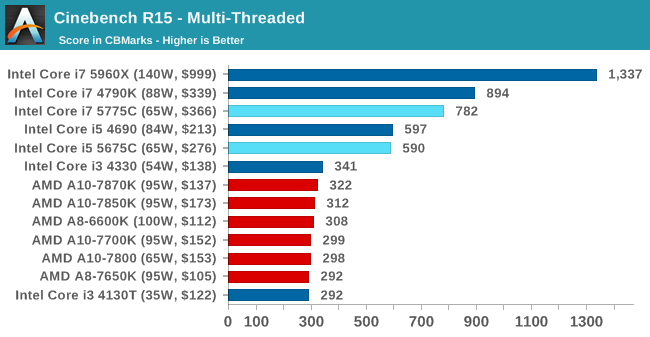
Cinebench is a historically CPU-limited benchmark, and the results show this again here. The fact that the 3.6GHz Broadwell-based i5-5675C performs so closely to the 3.9GHz Haswell-based i5-4690 is a promising sign here, as it means that despite being a mere "tick" in Intel's development efforts, there are tangible IPC increases on the desktop from Broadwell.
HandBrake v0.9.9: link
For HandBrake, we take two videos (a 2h20 640x266 DVD rip and a 10min double UHD 3840x4320 animation short) and convert them to x264 format in an MP4 container. Results are given in terms of the frames per second processed, and HandBrake uses as many threads as possible.
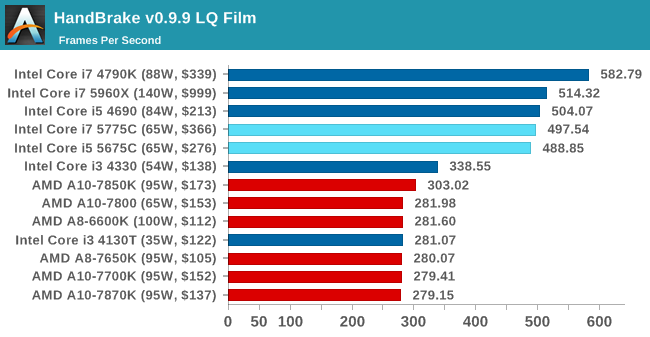

While no obvious improvement was seen in the low quality conversion, the double UHD conversion put the i7 above what was otherwise expected.
Hybrid x265
Hybrid is a new benchmark, where we take a 4K 1500 frame video and convert it into an x265 format without audio. Results are given in frames per second.
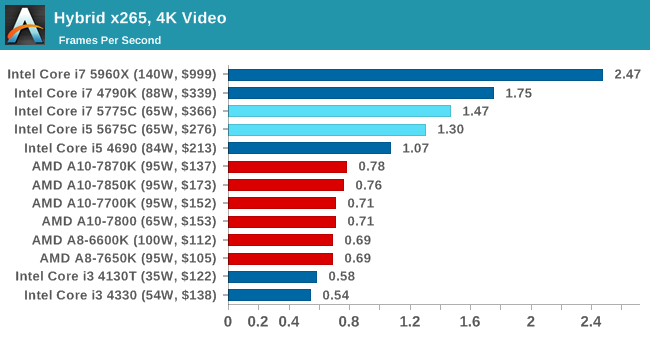
Unlike the Handbrake H.264 tests, the Hybrid x265 tests show a clear uptick in performance on the Broadwell processors. It is not fast enough to catch the i7-4790K and its 4.4GHz turbo clockspeed, but we see the i5-5675C shoot well past the i5-4690 despite the clockspeed deficit. Whether this is due to Broadwell architecture enhancements, Crystal Well acting as an L4 cache, or a combination of the two is difficult to determine, but the end result is substantial.










196 Comments
View All Comments
HotRod917 - Tuesday, June 2, 2015 - link
Hahaha.."lay the smackdown"..on Broadwell's candy A#$..! good one ;)Asomething - Tuesday, June 2, 2015 - link
So can you guys include 2400mhz ram in part 2 gaming benchmarks? it would be interesting to see what both sides gain from the faster ram.bobjones003@gmail.com - Tuesday, June 2, 2015 - link
Well I see no reason to upgrade yet maybe when skylake drops. My sandy bridge(i 5 2500k) will go for another generation. The cpu runs overclocked to 4.7 ghz at this I could save boat load of power on the system.Shadowmaster625 - Tuesday, June 2, 2015 - link
This review is also bunk due to the fact that they are usign a DDR3 card when even the same card with GDDR5 is way faster and only marginally more expensive. No one in their right mind even buys a gpu with DDR3 onboard.bloodypulp - Tuesday, June 2, 2015 - link
5 Years after the first AMD APU with graphics on-die, Intel finally has graphics on die.Well done Intel. *slow clap*
Peichen - Tuesday, June 2, 2015 - link
And AMD market share on CPU and GPU have been going from what to what in those 5 years? Kinda like how Bulldozer was the first "true" quad-core but managed to run at 60% of the speed of "fake quad" Q6600 and being hot as hell.bloodypulp - Tuesday, June 2, 2015 - link
Process advantage, much of it.olafgarten - Tuesday, June 2, 2015 - link
Technically Intel did graphics on-die first, they did it back in January 2010 with HD Graphics on the Clarkdale and Arrandale. It was in June 2011, when AMD released their first APU.Ryan Smith - Wednesday, June 3, 2015 - link
Clarkdale was a separate GPU die, on-package with the CPU. Intel didn't integrate the GPU on to their CPU until Sandy Bridge in January of 2011.HotRod917 - Tuesday, June 2, 2015 - link
Hey whats the whole"Thank you A for X
Thank you B for Y"...huh, whats goin on AT? Dare i say sarcasm towards manufacturer's being cry babies for not thanking them enough.
And speaking of manufacturer's...AMD its high time u pull a miracle (zen) and 'bring it, I mean the monopoly from the blue team is just ridiculous...for god sake AMD plz. Also ARM and Samsung ur welcome to join the desktop x86 party anytime..and the sooner the better.
Meanwhile i'll be rockin my delidded 3570k till skylake is out